|
|
 |
Fiche d'espèce de Copépode |
|
|
Harpacticoida ( Ordre ) |
|
|
|
Thalestroidea ( Superfamille ) |
|
|
|
Miraciidae ( Famille ) |
|
|
|
Distioculus ( Genre ) |
|
|
| |
Distioculus minor (T. Scott, 1894) (F,M) | |
| | | | | | | Syn.: | Miracia minor T. Scott, 1894 b (p.102, figs.F,M); Thompson & Scott, 1903 (p.237, 257); Steuer, 1935 a (p.393, fig.F, carte); Lang, 1948 a (p.770, figs.F,M); De Decker & Mombeck, 1964 (p.14); ? Soyer-Gobillard, 1965 (p.224, figs.F); Neto & Paiva, 1966 (p.36, Table III); Owre & Foyo, 1967 (p.105, figs.F,M); Wells, 1970 (n°133, p.5, figs.F,M); Razouls, 1972 (Annexe: p.146, figs.F,M); Boxshall, 1979 (p.235, figs.F,M, Rem.); Björnberg & al., 1981 (p.677, figs.F,M); Kovalev & Shmeleva, 1982 (p.85); Greze & al., 1985 (p.8); Bradford-Grieve & al., 1999 (p.886, 968, figs.F,M); Böttger-Schnack, 1995 (p.93); Suarez-Morales & Gasca, 1998 a (p.113); Gallienne & al., 2004 (p.5, tab.3); Khelifi-Touhami & al., 2007 (p.327, Table 1);Raybaud & al., 2008 (p.1765, Table A1); Macrosetella oculata : Sewell, 1947 (p.290) | | | | Ref.: | | | Huys & Böttger-Schnack, 1994 (p.243, figs.F,M); Böttger-Schnack, 1996 (p.1088); 1997 (p.410); Conway & al., 2003 (p.212, figs.F,M, Rem.); Boxshall & Halsey, 2004 (p.345: fig.F); Vives & Shmeleva, 2010 (p.110, figs.F,M, Rem.); Benedetti & al., 2016 (p.159, Table I, fig.1, functional characters) | 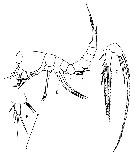 issued from : G.A. Boxshall in Bull. Br. Mus. nat. Hist. (Zool.), 1979, 35 (3). [p.236, Fig.16, E-G]. As Miracia minor. Female (Syntype from Gulf of Guinea): G, P5. Nota: Cuticular lenses not touching. P5 with 4 setae on baseoendopod, 1 very long and plumose, and 6 setae on exopod Male: E, habitus (lateral); F, P5. Nota: P5 with 2 setae on baseoendopod and 4 setae on exopod, 2 distally and 2 on the lateral margin.
|
 issued from : G.A. Boxshall in Bull. Br. Mus. nat. Hist. (Zool.), 1979, 35 (3). [p.235]. Armature formula of swimming legs P1 to P4. Roman numeral = spine; arabic numeral : seta; from inner to outer.
|
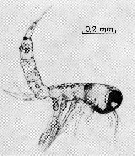 issued from : M.-O. Soyer-Gobillard in Vie et Milieu, 1965, XVI (1A). [p.224, Fig.1]. As Miracia minor. With doubt. Female (from Banyuls-sur-Mer): habitus (lateral). Nota: The specimen bera carried two egg-sacs, each with 4 eggs.
|
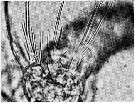 issued from : M.-O. Soyer-Gobillard in Vie et Milieu, 1965, XVI (1A). [p.225, Fig.2]. As Miracia minor. With doubt. Female: P5. Nota: leg 2-segmented; large inner lobe , which reachs approximately 1/3 of the exopodite, armed with 5 setae, the inner distal well developed. Exopodite 3 times as long as broad, with 6 setae; 3 outer well developedlike 2 inner distales,the outer distal thin and short.
|
 issued from : M.-O. Soyer-Gobillard in Vie et Milieu, 1965, XVI (1A). [p.225]. As Miracia minor. With doubt. Female: Chetotaxy of the swimming legs P2 to P4. Nota: P1 3-segmented, with exopodite , 2nd segment with 1 innner seta, distal with 4; endopodite 2-segmented with proximal segment, elongated, armed with 1 inner seta; distal segment, short.
|
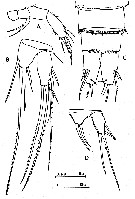 issued from : C. Razouls in Th. Doc. Etat Fac. Sc. Paris VI, 1972, Annexe. [Fig.101]. Female (from Banyuls, G. of Lion): A, A2; B, P5. Male: C, posterior part of urosome (dorsal); D, P5.
|
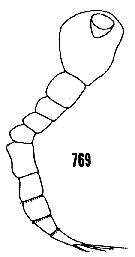 issued from : H.B. Owre & M. Foyo in Fauna Caribaea, 1, Crustacea, 1: Copepoda. Copepods of the Florida Current. 1967. As Miracia minor. After T. Scott (1894).[p.106, Fig.769]. Female: 769, habitus (lateral
|
 issued from : H.B. Owre & M. Foyo in Fauna Caribaea, 1, Crustacea, 1: Copepoda. Copepods of the Florida Current. 1967. [p.106, Fig.770]. As Miracia minor. Female: 770, P5.
|
 issued from : H.B. Owre & M. Foyo in Fauna Caribaea, 1, Crustacea, 1: Copepoda. Copepods of the Florida Current. 1967. [p.106, Fig.771]. As Miracia minor. After T. Scott (1894). Male: 771, P5.
| | | | | Ref. compl.: | | | Rezai & al., 2004 (p.490, tab.2, Rem.); Medellin-Mora & Navas S., 2010 (p.265, Tab. 2) | | | | NZ: | 7 | | |
|
Carte de distribution de Distioculus minor par zones géographiques
|
| | | | | | | | | | Loc: | | | South Africa (E), off Tristan da Cunha (N & E), Angola, Baia Farta, G. of Guinea, of S Cape Verde Is., off NE Amazon, Caribbean, Caribbean Colombia (San Andrés y Propvidencia), G. of Mexico, ? Gibraltar (in Thompson & Scott, 1903), Medit. (Alboran Sea, Gulf of Annaba, Banyuls, G. of Lion, Ligurian Sea, Lebanon Basin, off Mouth of the Nile), Red Sea, G. of Aden, Arabian Sea, SW Indian, Rodrigues Is. - Seychelles, Mascarene Basin, Straits of Malacca | | | | N: | 24 | | | | Lg.: | | | (57) F: 0,93; M: 0,93; (138) F: 0,93-0,9; M: 0,93-0,82; (721) F: 0,915-0,795; M: 0,92-0,77; (722) F: 1,74-0,93; M: 1,45-0,83; (991) F: 0,79-0,91; M: 0,77-0,92; {F: 0,79-1,74; M: 0,77-1,45} | | | | Rem.: | épipélagique.
Soyer-Gobillard (1965, p.223) décrit une femelle (Lg.: 0,83 mm) prélevée à Banyuls, et dont la chétotaxie ne coïncide pas avec celle donnée in Boxshall (1979). Si cette forme n'est pas considérée comme une espèce nouvelle (peut-être une anomalie), ce serait la première localisation en Méditerranée. Par contre les individus que j'ai récoltés à Banyuls (C.R) sont tout à fait conformes à la description de l'espèce.
Voir aussi les remarques en anglais | | | Dernière mise à jour : 04/12/2020 | |
|
|
 Toute utilisation de ce site pour une publication sera mentionnée avec la référence suivante : Toute utilisation de ce site pour une publication sera mentionnée avec la référence suivante :
Razouls C., Desreumaux N., Kouwenberg J. et de Bovée F., 2005-2026. - Biodiversité des Copépodes planctoniques marins (morphologie, répartition géographique et données biologiques). Sorbonne Université, CNRS. Disponible sur http://copepodes.obs-banyuls.fr [Accédé le 07 janvier 2026] © copyright 2005-2026 Sorbonne Université, CNRS
|
|
 |
 |










